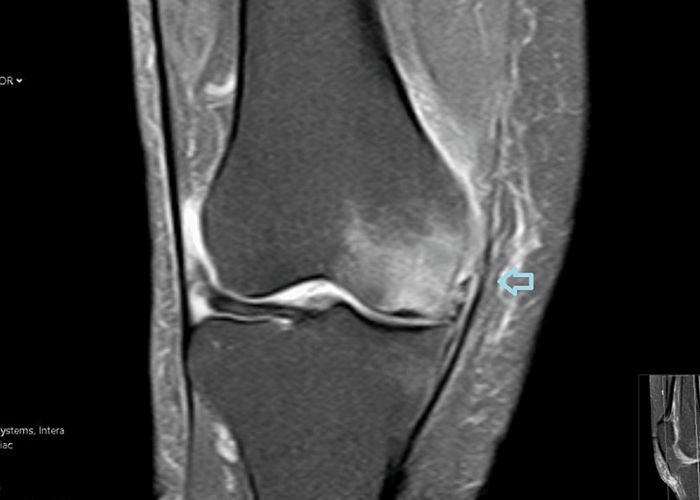Our knee joint’s intricate structure provides us with movement and stability for our daily activities. One such sickness is a subchondral insufficiency fracture of the knee, a relatively uncommon yet catastrophic orthopedic condition. We’ll examine the causes, signs, diagnosis, and treatment options for knee subchondral insufficiency fractures in this article. Let’s read below,” Subchondral Insufficiency Fracture of the Knee”.
Anatomy of the Knee Joint
Understanding the fundamental anatomy of the knee joint is necessary to fully understand fractures caused by subchondral insufficiency. The tibia (shin bone), patella (kneecap), and femur (thigh bone) combine to form the knee, which is a hinge joint. Articular cartilage, a smooth, slick layer covering the ends of the bones, facilitates easier movement of joints. The subchondral bone, a thick layer that supports the articular surface, is located beneath the cartilage.
What is Subchondral Insufficiency Fracture?
One kind of stress fracture that can happen in the subchondral bone—which is located beneath the articular cartilage of the knee—is called a subchondral insufficiency fracture. The tibial plateau and the femoral condyles, both of which bear weight, are the main areas of the knee joint that are impacted by this condition.
Causes of Subchondral Insufficiency Fracture of the Knee
Osteoporosis is characterized by a reduction in bone density, heightening the susceptibility of the subchondral bone to fracture under normal mechanical pressures.
Excessive or repetitive stress, exemplified by prolonged engagement in activities like running, jumping, and high-impact sports, can subject the knee joint to repeated strain, elevating the likelihood of subchondral insufficiency fractures.
Menopause induces hormonal changes affecting bone density, rendering women more susceptible to subchondral insufficiency fractures. This diminished integrity heightens the risk of fractures in the subchondral bone.
Symptoms of Subchondral Insufficiency Fracture
Early diagnosis and effective treatment of subchondral insufficiency fractures depend heavily on the ability to recognize their symptoms. Typical symptoms consist of:
Inflammation and Swelling: The fracture-induced inflammation can lead to swelling in the vicinity of the affected knee joint.
Diagnosis of Subchondral Insufficiency Fracture
Clinical Evaluation: To evaluate the patient’s symptoms, identify potential risk factors, and rule out other knee issues.
Magnetic Resonance Imaging (MRI): One incredibly delicate imaging strategy that can recognize subchondral inadequacy cracks and give data about the position and size of the break is attractive reverberation imaging (X-ray).
Treatment Options for Subchondral Insufficiency Fracture
Conservative Management:
Rest and Activity Modification: Relaxation and Support Change: The patient’s bone can recuperate by diminishing weight-bearing exercises and giving them enough rest.
Physical Therapy: : A couple of activities can ease torment, support joint dependability, and accelerate the mending system.
Pain Management: To decrease agony and irritation, specialists might suggest narcotics or nonsteroidal mitigating drugs (NSAIDs).
Surgical Interventions:
Minimally Invasive Procedures: In specific occurrences, it very well may be important to utilize negligibly obtrusive procedures like arthroscopy to fix the crack and any subsequent ligament harm.
Osteotomy: On the off chance that the break is connected to a skewed knee joint, realignment tasks could be thought about.
Nutritional Supplements:
Prognosis and Complications
Chronic Pain: Fractures that go untreated for a long time can cause chronic pain and impairment.
Cartilage Damage: Subchondral insufficiency from fractures can harm the articular cartilage underneath them, delaying the onset of osteoarthritis.
Prevention of Subchondral Insufficiency Fractures
Subchondral insufficiency fractures can be prevented by adopting a bone-healthy lifestyle and addressing any underlying causes. Here are some things you can do to lower your risk of a fracture caused by subchondral insufficiency:
Maintain healthy bones by eating a well-rounded diet heavy in calcium and vitamin D. Yogurt, milk, and dark green vegetables are all good options, as are vitamins and minerals. Consult a medical professional or trainer to come up with a plan that’s best for you.
Remove potential trip hazards from your home, fasten loose carpeting, and install railings in any areas where people are likely to take a tumble.
The best method to monitor your bone health and rule out any underlying disorders that might increase your risk of fractures is to schedule routine doctor’s visits.
Swimming and cycling are examples of moderate-impact exercises that may be beneficial for health and joints.
Your doctor may recommend bone density testing (DEXA scan) to evaluate your bone health depending on your age, gender, and risk factors.
Getting off of tobacco and cutting back on booze:
It has been established that quitting smoking instantly improves bone density. Drinking alcohol in moderation is recommended for good health.
Conclusion
Subchondral insufficiency fractures of the knee require expert knowledge for accurate diagnosis and treatment. Early symptom detection and the use of suitable imaging examinations are essential for developing a tailored therapy approach. I hope you like reading”Subchondral Insufficiency Fracture of the Knee”.

